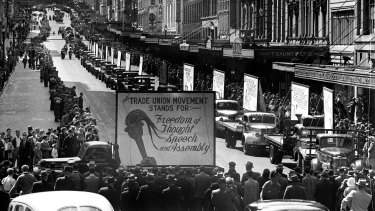Labour Day has become Victoria’s forgotten public holiday. The significance of the day and the events it commemorates have faded from public memory.
For almost 100 years from 1856, Eight Hour Day marches were the largest public celebrations that Victoria saw.
This is a great shame, because Labour Day celebrates a home grown achievement that is one of Melbourne’s greatest contributions to humanity. It also puts a spotlight on the quality of our working lives, a subject that is just as relevant today as it was 160 years ago.
The Eight Hour Day was a campaign by the labour movement in the 1850s that brought about important changes to the rights of workers. In the 1800s, most Victorians worked up to 14 hours a day, six days a week. There was no sick leave, no holiday leave and employers could sack employees at any time, without giving a reason.
The Eight Hour Day campaign was based on the ideal of an eight-hour working day with “eight hours labour, eight hours rest and eight hours recreation”. The campaign came to a head in 1856 when stonemason James Stephens led tradesmen from the construction site of the University of Melbourne on a march through the Hoddle Grid. The procession picked up tradesmen from other building sites and eventually arrived at the steps of Parliament House, which was also a construction site at the time. The Parliamentarians agreed to their claims, granting a reduction in the working day from 10 to eight hours, without a pay reduction.
It was a victory that became famous the world over. The eight-hour day spread to other trades, across the Australian colonies and to other nations. It was a pivotal point in Victoria’s political history and paved the way for other advances in people’s working rights. It was a victory achieved through struggle but without bloodshed.
When the French author and politician Albert Metin arrived in Australia in 1899 he described the antipodes as a “workers’ paradise”. A place where the advancement of workers’ rights were not based on political theory but rather a series of pragmatic steps taken to address specific issues: the eight-hour day, the minimum wage, compulsory arbitration, setting limits to the rights of property, the democratic vote and many other measures.
These accomplishments were celebrated each year on Labour Day. For almost 100 years from 1856, Eight Hour Day marches were the largest public celebrations that Victoria saw, attracting tens of thousands of people with parades held in Melbourne and country towns across the state.
During the Depression era of the 1930’s and the Second World War the marches began to decline, with the final march held in Melbourne in 1951. The Moomba Parade unofficially replaced the Eight Hour Day procession when it commenced in 1955.
Advertisement
Some people may question the relevance of the Eight Hour Day to our current working lives. But the truth is we do need to have a long hard look at the rights and conditions for modern day workers.
The Australian workforce is now skewed between people who are working too many hours (more than 45 hours a week) and those who cannot get enough hours (the underemployed).
For many of us, the working day has become blurred as online technologies and smart phones have moved the office into our homes and deep into what used to be private time.
Australian workers have not had a pay rise in five years. The economy has grown, unemployment has fallen, corporate profits have surged, but the benefits have not flowed through to higher wages for workers like the economic text books say they should.
We need our political, community and business leaders to tell us what are they going to do about this? We need to be better articulating how we want to improve our working lives?
We did not become a “workers paradise” in the 19th century because of complacency. We won it through struggle and because at least once a year on Labour Day tens of thousands of people used to march in the street and say “this is important to us”.
As Albert Metin put it, Australia had the ingenuity of a young democracy willing, in the face of the harsh conditions, to take risks and to experiment, with the spirit of “let’s try this idea”.
Labour Day is our chance to rekindle that spirit.
